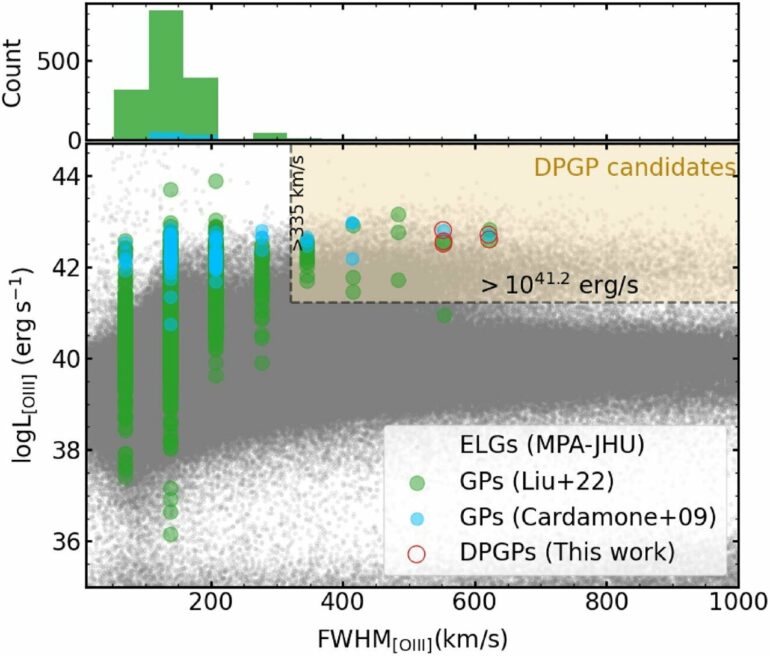Astronomers from Shanghai Astronomical Observatory (SHAO) of the Chinese Academy of Sciences and their collaborators have found five Green Pea (GP) galaxies with double-peaked narrow lines among nearly 1,550 GP galaxies. These objects may originate from dual active galactic nuclei (AGN) mergers, potentially revealing the co-evolutionary characteristics of a special class of high-mass galaxies and supermassive black holes.
The study was published in Monthly Notices of the Royal Astronomical Society on July 19.
GP galaxies are named for their green and compact optical appearance and are characterized by strong emission lines, particularly the doubly ionized oxygen [OIII] emission line. They are typically low-redshift galaxies with small mass, low metallicity, and active star formation. They are considered analogs of early galaxies in the nearby universe. Some show signs of AGN activity, indicating the actively accreting supermassive black holes in their nuclei.
Systematic searches and studies of GP galaxies could help us understand the formation and evolution of early galaxies. AGN samples within these galaxies provide insights into the co-evolution of early supermassive black holes and their host galaxies.
The researchers used a GP galaxy sample mainly from Extra-galactic Survey of the Large Sky Area Multi-Object Fiber Spectroscopic Telescope (LAMOST). It is currently the largest collection of GP galaxy spectra, encompassing nearly 1,550 GP galaxy spectra, which is more than double the number of GP galaxies identified in the Sloan Digital Sky Survey (SDSS).
By conducting an analysis of the emission line profiles of the LAMOST and SDSS spectra, the researchers discovered five GP galaxies with double-peaked narrow lines. Using multi-band photometry and optical spectral diagnostics, they reliably confirmed the AGN activity in this sample. Based on emission line profiles and optical morphologies, the physical origin of the double-peaked profiles in these galaxies is more likely attributed to dual AGN mergers rather than outflows or accretion disks.
According to Lin Ruqiu, Ph.D. student at SHAO and first author of the study, “These five galaxies have a narrow line width for each component and lack obvious inclination. Therefore, the double-peaked emission lines are less likely originated from outflows or gas disks.”
“These five GP galaxies exhibit stronger [OIII] equivalent widths compared to double-peaked emission line galaxies in Type 2 AGN. The underlying cause of this phenomenon may be related to galaxy mergers in the early universe,” said Prof. Zheng Zhenya from SHAO, corresponding author of the study. “The upcoming new phase of the LAMOST Extra-galactic Survey holds promise for providing us with more samples of such unique galaxies, further unraveling the co-evolution of massive galaxies and supermassive black holes.”
More information:
Ruqiu Lin et al, Discovery of five Green Pea galaxies with double-peaked narrow [O iii] lines, Monthly Notices of the Royal Astronomical Society (2023). DOI: 10.1093/mnras/stad1857
Provided by
Chinese Academy of Sciences
Citation:
Astronomers discover five Green Pea galaxies with double-peaked emission lines (2023, July 31)



